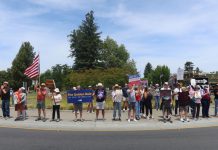Laura is a cold caller. Like any cold caller, she spends her
time trying to convince her target demographic to accept the
service she’s offering.
But Laura isn’t peddling tech support, a new cell phone or a
Hawaiian timeshare. Every week, she sorts through police reports to
find her target demographic: domestic violence victims. And every
week, she calls women and men to offer them support and guidance at
a critical time in their lives.
“You can’t expect everyone to want help right away,” Laura, who
requested that her last name be omitted to protect the anonymity of
her clients, said. “When you contact them, they’ll either talk to
you or not; they’ll either be polite or not. You never know what
they’re going to be. But if they aren’t ready to accept help at
that point, maybe they’ll be ready later. A lot of my hotline calls
come from women who had a report four or six months ago, and
something happened again and then they realize, Okay, I’ve gotta do
something.”
Laura admits that cold calling isn’t an easy job, especially
since it isn’t her real job. (She has one of those, too, in an
entirely unrelated field.) Laura is a YWCA volunteer community
advocate at the Healdsburg Police Department. All police reports
involving domestic violence — or potential domestic violence — are
funneled to her desk so that she may assess the victim’s risk and
contact them with appropriate support and information.
When Laura isn’t volunteering at the police department or
working at her nine-to-five job, she can often be found
volunteering at the YWCA’s Safe House. She spends one full day at
the Safe House each week, teaching a Life Skills class to residents
and then helping out around the house. Life Skills covers
everything from cooking and cleaning to money management and
growing food in the backyard, and is designed to empower and
educate women in a support group setting.
“I show up on Thursday morning, teach my Life Skills group and
I’m there the rest of the day,” Laura said. “I do whatever’s
needed. I help clients, I clean, I replace lights. We put in a
vegetable garden. We go to the stores and transport clients. We
answer the hotline and do Safe House intakes. It’s whatever’s going
on, whatever I can help them with.”
Victims who require residence at the Safe House first meet
advocates at a separate safe location. There, they work with the
advocate to complete the necessary intake procedures before moving
into the Safe House. While this process—and, more generally, the
experience of working face to face with recent victims of domestic
violence—might sound stressful and emotionally draining for a
volunteer, Laura insists that it isn’t.
“You can picture it: you walk into the building and the woman’s
sitting there with her children,” Laura said. “It’s taken an
amazing amount of power for her to do this. And all you’re feeling
for her is, ‘I’m gonna make sure she’s okay.’”
As for the continuing work at the Safe House, Laura said, “Once
you start working there, the advocates and the manager of the Safe
House are incredibly supportive of one another, so nothing feels
stressful.” She paused. “Except, for me, changing a diaper.”
Still, Laura admitted, there are challenges. Even with 40 hours
of training, it takes a sensitive ear and considerable compassion
to hear what battered women are really saying.
“Somebody calls you on the hotline, and they might have a
question or a comment, but you’re looking for why they’re really
calling,” Laura said. “The challenge is listening. It’s easy to
have somebody call and not question what they’re saying, and then
they hang up the phone and haven’t gotten any help. People are
afraid to come out and say ‘I’m afraid of my husband.’ They might
call asking for a support group or they might call asking for
counseling, but rarely do they come out and say ‘I’m
petrified.’”
Laura estimates that only one in a dozen callers will actually
communicate directly about how serious their situation is. The
others require a delicate touch to help them open up and receive
the appropriate support.
Laura is a lifelong volunteer, from middle school to her
mid-fifties. She has been working with domestic violence victims
for four years, and began her work at the very first Family Justice
Center in San Diego.
She takes her duty to her clients very seriously. “The man I
live with doesn’t even know where the Safe House is,” she
said—despite the fact that she spends one day out of every seven
volunteering there.
But Laura is not one to step up and take credit. “I don’t want
it to be about me,” she said. “I want new volunteers to go through
the 40 hour training and find out how rewarding it is. We need
women with skills. I’m trying to teach them [the residents] yoga,
and I know exactly two poses. But to come in to the Safe House, a
yoga teacher would need to take the 40 hour training. So either
take the training and volunteer, or give… we need new freezers, new
refrigerators. We need a handyman or handywoman.”








